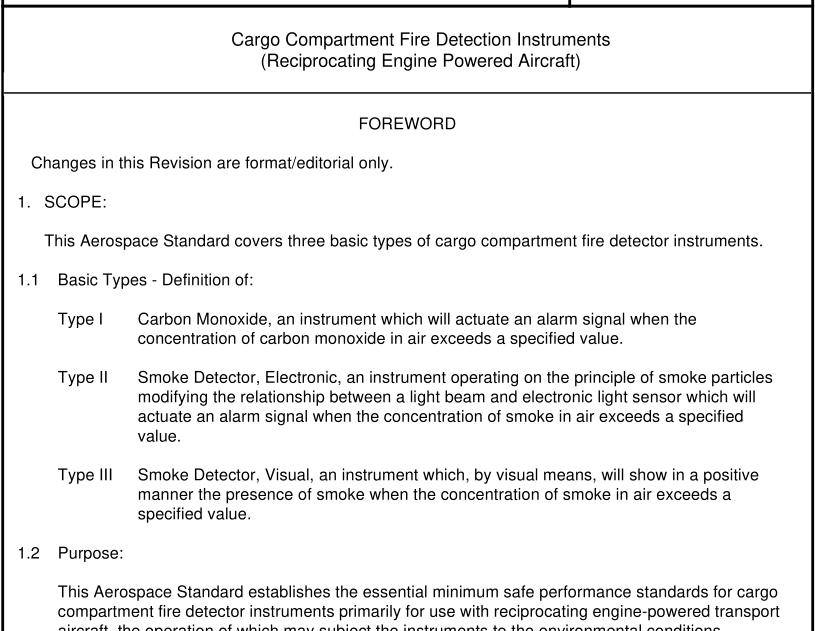SAE AS 400B:2001 pdf download Cargo Compartment Fire Detection Instruments (Reciprocating Engine Powered Aircraft)
1 . SCOPE:
This Aerospace Standard covers three basic types of cargo compartment fire detector instruments.
1 .1 Basic Types – Definition of:
Type I Carbon Monoxide, an instrument which will actuate an alarm signal when the concentration of carbon monoxide in air exceeds a specified value.
Type II Smoke Detector, Electronic, an instrument operating on the principle of smoke particles odifying the relationship between a light beam and electronic light sensor which will actuate an alarm signal when the concentration of smoke in air exceeds a specified value.
Type III Smoke Detector, Visual, an instrument which, by visual means, will show in a positive manner the presence of smoke when the concentration of smoke in air exceeds a specified value.
1 .2 Purpose:
This Aerospace Standard establishes the essential minimum safe performance standards for cargo compartment fire detector instruments primarily for use with reciprocating engine-powered transport aircraft, the operation of which may subject the instruments to the environmental conditions specified in Section 3.3.
2. REFERENCES:
NACA Report 1 235
3. GENERAL REQUIREMENTS:
3.1 Materials and Workmanship:
3.1 .1 Materials: Materials shall be of a quality which experience and/or tests have demonstrated to be suitable and dependable for use in aircraft instruments.
3.1 .2 Workmanship: Workmanship shall be consistent with high-grade aircraft instrument manufacturing practice.
3.2 Identification:
The following information shall be legibly and permanently marked on the instrument or attached thereto:
a. Name of Instrument
b. SAE AS400B
c. Manufacturer’s Part Number
d. Manufacturer’s Serial Number or Date of Manufacture
e. Manufacturer’s Name and/or Trade-mark
f. Rating (Electrical, Vacuum, Etc.)
g. Type Number
h. Alarm Setting
3.3 Environmental Conditions:
The following conditions have been established as minimum design requirements. Tests shall be conducted as specified in Sections 5, 6 and 7.
3.3.1 Temperature: When installed in accordance with the instrument manufacturer’s instructions, the instrument shall function over the ranges of ambient temperatures shown in Column A below and shall not be adversely affected by exposure to the range of temperatures shown in Column B below.
3.3.2 Altitude: The instrument shall function and shall not be adversely affected following exposure to a pressure and temperature range equivalent to -1 000 to 40,000 feet standard altitude per NACA Report 1 235, except as limited by application of Paragraph
3.3.1 . The Instrument shall not be adversely affected when subjected to an ambient pressure of 50 inches of mercury absolute. 3.3.3 Vibration: When installed in accordance with the instrument manufacturer’s instructions, the instruments shall function and shall not be adversely affected when subjected to vibrations of the following characteristics:
SAE AS 400B:2001 pdf download
